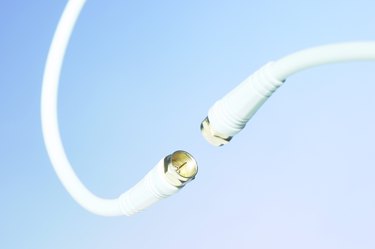
High-definition televisions are becoming more affordable and commonplace in homes. As HDTVs begin to replace traditional CRT TVs, homeowners must look at upgrading the wiring of their cable and satellite TV systems to take full advantage of the HDTV broadcast signal. The HDTV signals from broadcast and cable providers require cable and cable splitters that process more information than is needed for traditional, cathode ray tube TVs.
Analog Cable Splitters
Video of the Day
Analog cable splitters are found in many retail outlets and are inexpensive. These splitters break up an incoming cable TV signal to two or more different outgoing connections. Analog cable splitters tend to have a maximum capacity of 900 megahertz, below the frequency range of 720i and 1080i HDTV television signals. The measure of input power to output power of a signal is referred to as a decibel. A two-way splitter will decrease your signal strength by 3.5 dB, while a four-way splitter can cause losses of at least 7 dB in signal strength. A decrease in signal strength can result in a static-filled picture, duplicate images or a complete loss of signal.
Video of the Day
HDTV and Digital TV Splitters
HDTV signals for 720i and 1080i picture quality require a 1GHz minimum frequency response to transmit high-definition images and minimize the effects of digital artifacts, noise and freezing images. Most standard splitters have a maximum capacity of 900 MHz. This capacity results in picture quality drops and problems with maintaining a consistent signal. In addition to speed, choose a splitter that has a flat frequency response. Flat frequency response refers to the splitter's ability to maintain a standard frequency with minimum variations while in use.
Amplifiers
One way to present signal loss when using a digital cable splitter is to use a cable amplifier. The normal strength of the cable signal provided by the cable company provides a signal sufficient for two to three HDTVs. However, splitting your cable decreases the signal strength of your cable signal.
Types of Splitters
A two-way splitter takes one cable wire and splits it to two separate lines. This type of splitter is useful for homes in which you need only one additional cable connection. If you need to split your cable wire to three or more outgoing ports, you should consider a three-, four- or larger-port splitter used in conjunction with an amplifier. Splitting a cable line after it has been split with a two-way splitter causes signal degradation and image problems. Use a splitter with at least a 900 to 2150 MHz range when splitting HDTV transmissions. While a 900 MHz signal is not sufficient for HDTV transmissions, a splitter with a 900 to 2150 MHz range will cap at 2150 MHz but keep the frequency of your cable transmissions above 900 MHz. An analog splitter will not allow the frequency of your cable transmission above 900 MHz.